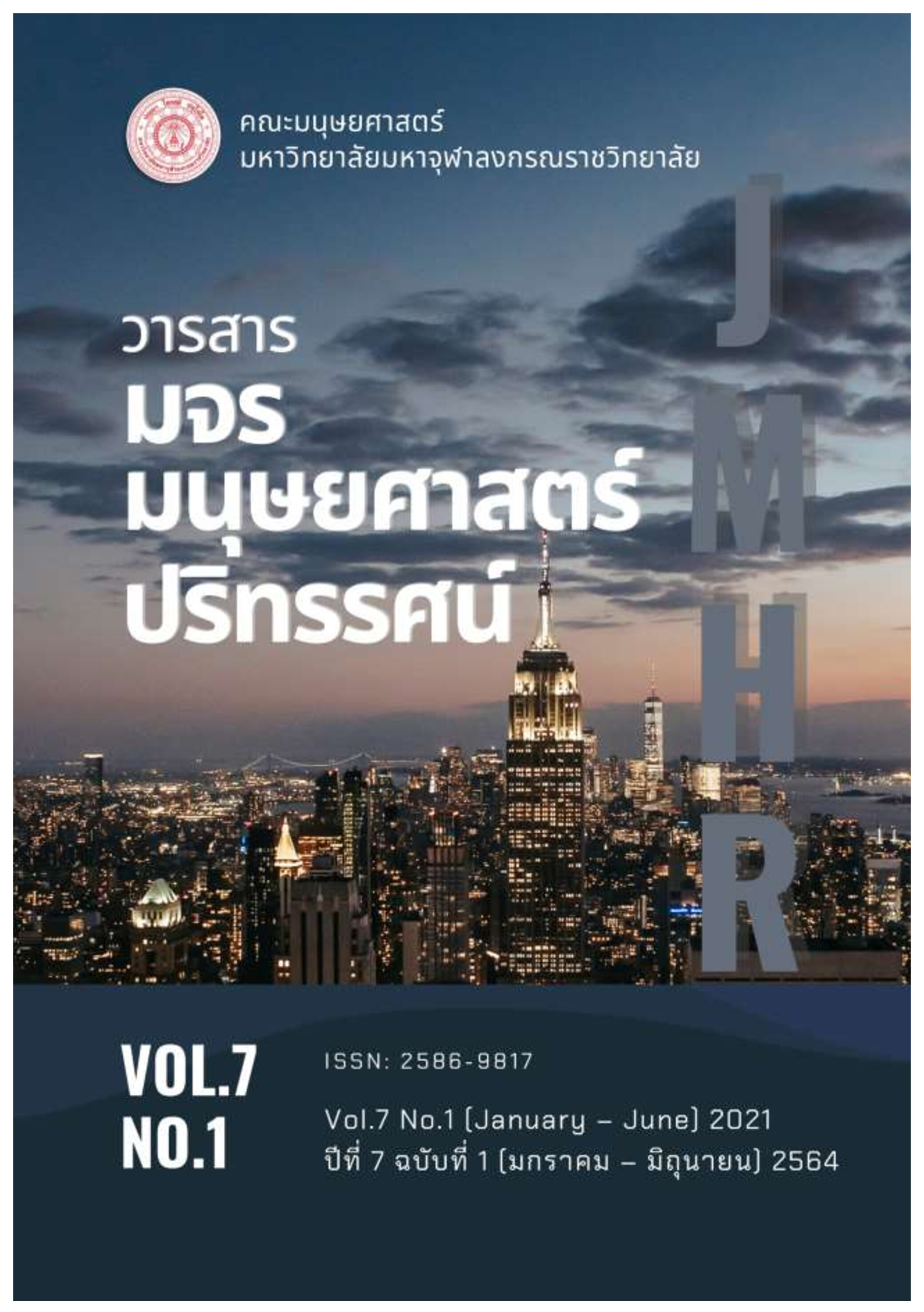ประสบการณ์การเยียวยาจิตใจผู้ป่วยของพระสงฆ์จิตอาสาคิลานธรรม
คำสำคัญ:
ประสบการณ์, การเยียวยาจิตใจ, ผู้ป่วย, จิตอาสา, พระคิลานธรรมบทคัดย่อ
การวิจัยครั้งนี้มีวัตถุประสงค์เพื่อศึกษาประสบการณ์การเยียวยาจิตใจผู้ป่วยของพระสงฆ์จิตอาสาคิลานธรรม เป็นการวิจัยเชิงคุณภาพแนวปรากฏการณ์วิทยา ผู้ให้ข้อมูล คือ พระสงฆ์จิตอาสากลุ่มคิลานธรรมที่มีประสบการณ์การเยียวยาจิตใจผู้ป่วย จำนวน 7 ราย ได้มาโดยการเลือกแบบเจาะจงตามเกณฑ์ที่กำหนด เครื่องมือที่ใช้ในการเก็บรวบรวมข้อมูล ได้แก่ แบบสัมภาษณ์เชิงลึก และแบบสังเกตแบบมีส่วนร่วม วิเคราะห์ข้อมูลโดยการวิเคราะห์เนื้อหา และสร้างข้อสรุปแบบอุปนัย
ผลการศึกษา พบว่า ประสบการณ์การเยียวยาจิตใจผู้ป่วยของพระสงฆ์จิตอาสากลุ่มคิลานธรรม มีประเด็นสำคัญ 4 ประเด็นหลัก ได้แก่ 1) ปฐมเหตุสู่การเป็นพระสงฆ์จิตอาสากลุ่มคิลานธรรม ประกอบด้วย 3 ประเด็นย่อย คือ (1.1) ใจที่ปรารถนาช่วยเหลือผู้อื่น (1.2) การเข้าสู่เส้นทางเยียวยา และ (1.3) ทรัพยากรในการดำเนินงานเพื่อให้เกิดความสำเร็จ 2) การฝึกฝนตนสู่การเยียวยา ประกอบด้วย 5 ประเด็นย่อย คือ (2.1) การเข้าใจชีวิต (2.2) การพัฒนาทักษะพื้นฐาน (2.3) ทักษะเฉพาะสำหรับการเยียวยา (2.4) การทบทวนตนเอง และ (2.5) คุณสมบัติของผู้เยียวยา 3) กระบวนการเยียวยาของพระสงฆ์จิตอาสากลุ่มคิลานธรรม ประกอบด้วย 6 ประเด็นย่อย คือ (3.1) ท่าทีที่มีต่อคนตรงหน้า (3.2) นิยามการเยียวยา (3.3) ขั้นตอนการเยียวยา (3.4) หลักธรรมที่ใช้ (3.5) ทักษะที่ใช้ และ (3.6) ปัจจัยที่เอื้อต่อความสำเร็จ และ 4) การเปลี่ยนแปลงโลกภายใน ประกอบด้วย 7 ประเด็นย่อย คือ (4.1) การเปลี่ยนแปลงตัวเอง (4.2) การเอื้อให้เกิดปัญญา (4.3) นิยามความหมายผู้ป่วย (4.4) หลักธรรมที่นำมาใช้จริง (4.5) การเห็นภาวะสุขใจ (4.6) เทคนิคเฉพาะตน และ (4.7) การเห็นคุณค่าของงานที่ทำ
เอกสารอ้างอิง
ทัศนีย์ เจนวิถีสุข. (2556). การสื่อสารเชิงพุทธกับการเปลี่ยนแปลงสังคม (วิทยานิพนธ์พุทธศาสตรดุษฎีบัณฑิต). พระนครศรีอยุธยา : มหาวิทยาลัยมหาจุฬาลงกรณมหาวิทยาลัย.
ธนภณ พันธเสน. (2554). กระบวนการเปลี่ยนแปลงสู่การพัฒนาอสังหาริมทรัพย์แบบยั่งยืน : จากกระบวนทัศน์อัตตาสู่บูรณาการ (วิทยานิพนธ์พุทธศาสตรดุษฎีบัณฑิต). พระนครศรีอยุธยา : มหาวิทยาลัยมหาจุฬาลงกรณมหาวิทยาลัย.
พระเทพสุวรรณเมธี และคณะ. (2562). พระจิตอาสาคิลานธรรม: รูปแบบและกระบวนการเยียวยาใจผู้ป่วยด้วยธรรมะ. วารสารสันติศึกษาปริทรรศน์ มจร., 7(6), 1786-1796.
พุทธทาสภิกขุ. (2534). วิธีระงับดับทุกข์, กรุงเทพมหานคร.
เพริศพรรณ แดนศิลป์ และคณะ. (2020). การเปลี่ยนแปลงมิติภายในของพระสงฆ์กลุ่มอาสาคิลานธรรมภายหลังการเข้าร่วมหลักสูตรการปรึกษาเขิงจิตวิทยาแนวพุทธและในระยะติดตามผลการปฏิบัติงานต่อผู้ป่วยระยะท้าย (รายงานผลการวิจัย). นครปฐม: มหาวิทยาลัยมหิดล.
สมบูรณ์ เอื้อมอารีย์วงศ์. (2556). แบบจำลองกระบวนการผุดบังเกิดแห่งสังคมตื่นรู้จากการก้าวข้ามของบุคคล : ศึกษากรณีประยงค์ รณรงค์และชุมชนไม้เรียง จังหวัดนครศรีธรรมราช (วิทยานิพนธ์พุทธศาสตรดุษฎีบัณฑิต), พระนครศรีอยุธยา, มหาวิทยาลัยมหาจุฬาลงกรณมหาวิทยาลัย.
สุพิชฌาย์ พรพิชณรงค์ และคณะ. (2561). การพัฒนาศักยภาพและกิจกรรมการเยียวยาใจผู้ป่วยด้วยธรรมะของกลุ่มพระจิตอาสาคิลานธรรม. วารสารบัณฑิตศึกษาปริทรรศน์ มจร., 40(3), 65-74.
เสริมศิริ อัครพุฒิพันธ์. (2555). การพัฒนาเพื่อก้าวข้ามพ้นตัวตนตามแนวพระพุทธศาสนาเถรวาท (วิทยานิพนธ์พุทธศาสตรดุษฎีบัณฑิต). พระนครศรีอยุธยา : มหาวิทยาลัยมหาจุฬาลงกรณมหาวิทยาลัย.
อรทัย มีแสง. (2555). การพัฒนาจิต : แนวคิดและการเปรียบเทียบเชิงพุทธบูรณาการ (วิทยานิพนธ์พุทธศาสตรดุษฎีบัณฑิต). พระนครศรีอยุธยา : มหาวิทยาลัยมหาจุฬาลงกรณมหาวิทยาลัย.
Browning. (1987). Religious Thought and Modern Psychology. Philadelphia: Fortress.
Daya.Rosini. (2005). Buddhist Movement in Psychotherapy. Integrating Traditional Healing Practice into Counseling and Pschoterapy, California :Seag Plublic,Inc.
Knowles & Shertzer. (1989). Attitude Toward The Role of Psychologist and Counselor. Journal of School Psychology. 16(3), 49-57.
Rogers, C., (1957). The necessary and sufficient conditions of therapeutic personality change”, Journal of Consulting Psychology, 21(2),95-103.






